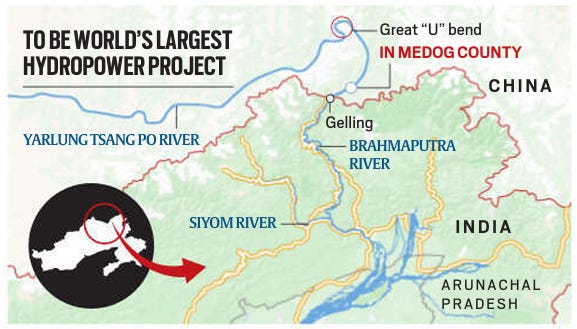#331: China's Mega dams
Implications & Concerns for India
How Chinese are changing earth’s rotation & India has (genuine) concerns?
Take a read
On July 19, 2025, China formally began constructing a mega dam on the Brahmaputra River in the Tibet Autonomous Region, a project that has sparked significant concern in India. Dubbed the world's largest hydropower project, this development has raised alarms about water security, geopolitical tensions, and environmental impacts.
The Project Unveiled
The dam, located near the Great Bend of the Brahmaputra in Medog County, is an ambitious endeavor with a staggering 60,000 MW capacity.
Focal point of international scrutiny because of its proximity to Indian border
The Brahmaputra, known as the Yarlung Tsangpo in Tibet, flows through India before merging with the Ganges, making it a critical lifeline for millions.
Concerns in India
India’s apprehensions are multifaceted.
Dam’s location upstream giving control to China affecting agri, hydropower & flood patterns in Arunachal & Assam
National Water Development Authority has emphasized the need to monitor this closely, given the river’s role in sustaining the Northeast’s ecosystem.
Environmentalists raised the potential harm to Himalayan ecology (landslides, biodiversity)
Altercation of sediment flow impacting fertile plains of Assam & loss of livelihoods
Geopolitical Tensions
Considered to be less of a dam and more of a geopolitical chess move, it reflects on tensions of India-China. This project intensifies existing tensions, with India viewing it as a strategic maneuver to assert dominance in the region.
Defense experts, including those from the Institute for Defence Studies and Analyses, suggest that China could use water as a tool for leverage, especially during diplomatic standoffs.
India’s response has been cautious yet firm. The government is investing in real-time hydrological data collection and has urged China to share data transparently, as agreed in past treaties. However, skepticism remains, with some analysts predicting that China might withhold critical information, further straining bilateral relations.
Historical Context and Mitigation Efforts
The Brahmaputra’s significance dates back centuries, with its waters shaping the cultural and economic fabric of the region. Historical treaties between India and China have aimed to ensure cooperative water management, but trust has been shaky.
In response to the dam, India is accelerating its own hydropower projects, such as the Subansiri Lower Dam, to reduce dependency on upstream flows.
Additionally, the country is enhancing diplomatic channels and collaborating with Bhutan and Bangladesh who are our downstream neighbors and also affected by the Brahmaputra in an attempt to form a unified stance.
Mitigation strategies include advanced monitoring systems and international pressure to enforce water-sharing agreements.
The establishment of user rights for the river’s states is under discussion, though progress is slow.
India’s scientific community is also conducting climate change assessments to predict long-term impacts, ensuring a data-driven approach to negotiations.
The Way Forward
As China progresses with this mega dam, the need for dialogue and transparency is more urgent than ever.
India must balance diplomatic efforts with domestic preparedness, investing in resilient infrastructure and community support in vulnerable regions.
The global community, including environmental organizations, should advocate for sustainable practices to protect this vital river system.
________________________________________________________________


